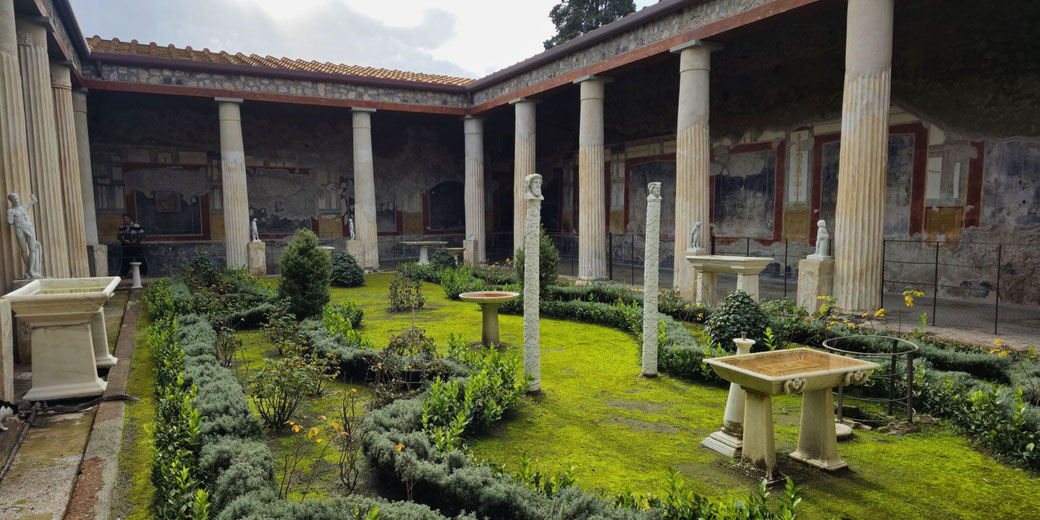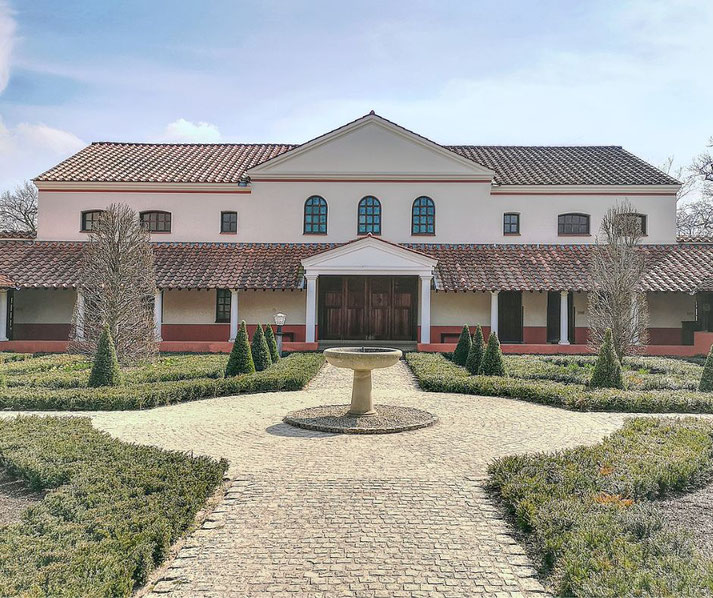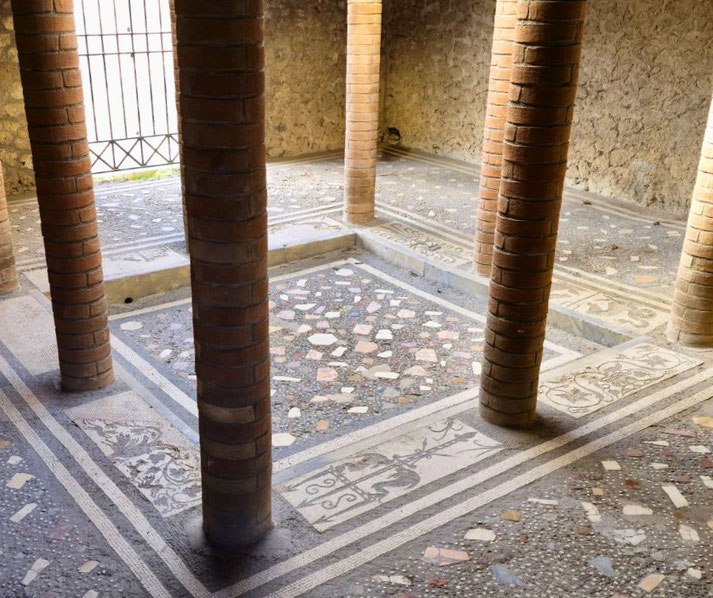What was it like to live in an ancient Roman villa?

A Roman villa was more than just a home; it was a statement of wealth, power, and refinement. As architectural marvels of the ancient world, these grand residences played a pivotal role in defining the lifestyle of the wealthy Roman elite.
Roman villas were not merely large houses; they were expansive estates situated outside the hustle and bustle of the city centre, often surrounded by lush vineyards, farmland, and gardens.
They were not only homes but also centers of production, often equipped with agricultural fields, vineyards, and sometimes even workshops for producing goods.
These remarkable residences reflected a life of luxury and abundance, symbolizing the high status of their owners.
What is a Roman villa?
A Roman villa was a type of residence that emerged during the Roman Republic (509-27 BCE) and was originally an ancient Roman upper class country house.
The term villa can refer to different kinds of structures, depending on the location and time period.
In general, villas were rural or suburban residences that were associated with leisure, agriculture, or production.
There were two main kinds of villas: the villa urbana, which was a country seat near the city, and the villa rustica, which was a farmhouse estate with a working area and a residential area.
Some villas were very luxurious and had features like mosaic floors, frescoes, gardens, baths, and fountains.
Some famous examples of Roman villas are Hadrian's Villa at Tivoli, the Villa of the Papyri at Herculaneum, and the Fishbourne Roman Palace in Sussex.

The different buildings which made up a villa complex
Roman villas were known for their architectural grandeur and luxurious design, serving as the centerpiece of a prosperous estate.
These grand residences were carefully designed to combine luxury with functionality, showcasing Roman engineering and artistic talent.
The core of the villa consisted of numerous rooms arranged around a central courtyard or peristyle.
This open-air garden was a common feature in Roman domestic architecture, offering a serene retreat within the villa.
It was typically adorned with ornamental plants, fountains, and often, exquisite statuary.
Surrounding the peristyle, you would find various rooms including the atrium, the main formal reception room where the villa's owner, or 'dominus', would receive his guests; the 'cubicula' or bedrooms; and the 'triclinium', the formal dining room where elaborate meals were served.

One of the significant innovations in the architecture of some Roman villas was the hypocaust, an early form of central heating.
The hypocaust system used furnaces to circulate hot air beneath the floor and within the walls of the villa, providing warmth in colder climates and ensuring the comfort of its inhabitants.
The design and layout of the villas often differed based on their location and the period in which they were built.
For instance, villas in the Italian countryside were more likely to be focused on farming and would include extensive agricultural buildings, while those near the coast might have been built as luxurious retreats with an emphasis on relaxation and entertainment.
Apart from the main villa, the estate would typically include various auxiliary buildings such as stables, barns, storage facilities, workshops, and sometimes even a private chapel or temple.
The villa and its auxiliary structures were usually surrounded by lush gardens, vineyards, or farmland, emphasizing its role in economic production.
Who lived in a Roman villa?
A Roman villa was home to a diverse group of individuals, each with distinct roles and status within the household.
While the villa was a sign of wealth and prosperity, the life within its walls showed the clear-cut hierarchies and social distinctions of Roman society.
At the top of the hierarchy was the 'dominus' or master, typically a wealthy Roman citizen.
The dominus could be a member of the senatorial class, an equestrian, or a successful merchant, whose wealth enabled him to afford such a luxurious residence.
Often, he would use the villa as a country retreat away from his urban dwelling in Rome or other cities.
The family of the dominus, known as the 'domus', also resided in the villa. This included his spouse, children, and sometimes extended family members.
Their rooms were usually private and well-furnished, reflecting their high social standing.
Another critical part of the villa's community was the slaves. They performed a wide range of tasks, from domestic chores such as cooking, cleaning, and serving meals to managing the estate's agricultural work.
Slaves could also hold more specialized roles, such as tutors for the children, personal attendants, gardeners, or artisans.
Their living quarters were distinctly separate, often smaller and more austere.
Freedmen, or former slaves who had been granted their freedom, might also live on the estate.
They sometimes continued to work for their former masters, often in supervisory roles.
In some cases, they managed the estate in the absence of the dominus, maintaining the property and overseeing the work of the slaves.
In larger villas, there may also have been guest quarters for visiting friends, relatives, or dignitaries.
These guest quarters would have been comfortable and well-appointed, as hospitality was a significant aspect of Roman culture.
Lastly, the Roman villa was also home to a myriad of animals - working animals like horses and oxen, pets such as dogs and birds, and game animals kept for hunting or entertainment.
What a typical day looked like
The daily life in a Roman villa was a combination of work, leisure, and social activities, distinctly defined by the status of its inhabitants.
While the master and his family enjoyed a life of comfort and relaxation, the slaves worked tirelessly to ensure the smooth running of the household.
A typical day in the life of a Roman villa began at dawn. For the slaves, the day started early with chores such as cleaning the villa, preparing meals, tending to the gardens, or working on the agricultural lands.
Cooks would begin preparations for the day's meals, while maids and manservants busied themselves with cleaning and maintaining the villa.
The villa's overseer, often a trusted slave or a freedman, would manage the day-to-day running of the estate, supervising the work of the slaves and ensuring that tasks were carried out efficiently.
For the dominus and his family, the day might begin with a light breakfast, often consisting of bread, cheese, and sometimes fruit.
After breakfast, the dominus might deal with the management of the estate, making decisions about planting and harvesting crops, selling produce, and any other financial matters.
He could also spend time receiving guests, discussing politics, or engaging in intellectual pursuits such as reading or writing.
Children in the villa would usually have a schedule of education and recreation. A private tutor, often a learned slave, might teach them reading, writing, mathematics, and principles of Roman law and morality.
Children might also learn about mythology and history through storytelling sessions.
Meals were an important part of the day in a Roman villa. The main meal, or 'cena', was a grand affair, often served in the late afternoon or early evening.
It was a social event, with family members, and sometimes invited guests, reclining on couches while slaves served a variety of dishes.
Leisure activities also played a significant part in villa life. The Romans enjoyed games, music, and other forms of entertainment.
The dominus and his family might spend time in the villa's garden, take a dip in the private bath, or indulge in a reading session in the villa's library.
The day would end with the setting of the sun, as artificial lighting was expensive in Roman times.
Nighttime was typically for resting, though on special occasions, feasts or celebrations might extend into the night.
A villa was also a thriving business
While Roman villas were undeniably symbols of opulence, they also played a significant role in production, trade, and wealth generation.
Agriculture was the primary economic activity of most Roman villas. Some villas were self-sufficient estates, producing a variety of crops, fruits, and vegetables to feed their inhabitants and workers.
The surplus was sold or traded, contributing to the wealth of the dominus. Depending on the region and the fertility of the land, common crops included grains, olives, grapes for wine, and vegetables.
Many villas also maintained orchards and herb gardens.
Livestock farming was another critical economic aspect. Animals such as sheep, cattle, pigs, and poultry were raised not only for food but also for their by-products like wool, milk, and eggs.
Horses and oxen were also kept as work animals, crucial for transportation and agricultural work.
In addition to farming, Roman villas were also centers of craft production. Workshops within the villa produced goods such as pottery, metalwork, and textiles.
Many Roman villas were strategically located near trade routes or bodies of water to facilitate trade.
The surplus produce from the villa, whether it was wine, olive oil, grain, or manufactured goods, was sold or traded in local markets or even exported further afield.
In turn, the villa's inhabitants could purchase luxury goods not produced on the estate, such as spices, exotic foods, or fine textiles.
The economic activities of a villa were carefully managed, often by a skilled steward or overseer, usually a trusted slave or a freedman.
This individual was responsible for overseeing the production, maintaining the accounts, managing the workforce, and ensuring the villa's economic prosperity.
As you can see, a villa was not just a luxurious residence but also a thriving economic unit that contributed to the wealth of the dominus and the broader Roman economy.
How to impress the neighbours
The Roman villa was more than just a home or an economic hub; it was an emblem of social status and wealth, a tangible demonstration of the owner's place in the societal hierarchy.
Owning a villa was a testament to the economic success and influence of the dominus, playing a vital role in their social interactions and public persona.
From the size of the estate to the architectural grandeur of the villa, every aspect was designed to impress.
The architectural sophistication, the opulent decorations, the intricate mosaics and frescoes, the luxurious private baths, and even the well-manicured gardens all signaled wealth and taste.
These elements did not just provide comfort for the inhabitants, but they were also intended to awe guests and elevate the owner's social standing.

The location of a villa could also contribute to its status. Villas in certain desirable locations, such as the Bay of Naples, were particularly prized.
Beyond the physical aspects, the activities and lifestyle associated with the villa also signaled status.
The ability to entertain guests with elaborate feasts, to maintain a large number of slaves and workers, or to indulge in leisure activities like hunting, bathing, or intellectual pursuits, were all signs of affluence.
The act of patronage was another significant aspect of the villa as a status symbol.
Many villa owners would fund public works, sponsor festivals, or donate to religious institutions, often using the wealth generated from the villa's economic activities.
This not only increased their reputation but also cemented their status within the community.
However, the villa was not just a status symbol for the living. Roman funerary practices often involved the display of images of the deceased's property, including their villa, on their tombstones.
This served as a lasting testament to their wealth and status, extending beyond their lifetime.
The religious items and practices within a villa
Religion was a central aspect of Roman life, permeating every facet of daily existence, and the Roman villa was no exception.
From household worship to grand religious feasts, the villa served as a stage for numerous religious practices and rituals, reflecting the spiritual beliefs and traditions of its inhabitants.
Every Roman villa typically housed a 'lararium', a sacred space dedicated to the household gods known as the 'Lares'.
These deities were believed to protect the home and its inhabitants, and daily rituals were conducted in their honor.
The dominus or another family member would usually lead these rituals, which involved prayers, offerings of food, and sometimes wine.
The lararium often featured small statues or images of the Lares and other significant deities, and was a central focus for the spiritual life of the villa.
Many Roman villas also had private chapels or shrines dedicated to various Roman gods and goddesses. Larger villas might even have small temples within their grounds.
These were sites for more formal worship and could also serve as venues for religious festivals and ceremonies.
During these events, elaborate rituals were performed, feasts were held, and sometimes games or theatrical performances were organized.
In addition to the Roman pantheon, the spiritual life of a Roman villa often included veneration of the 'genius' of the dominus, the divine aspect of his personal spirit.
Birthdays and other significant life events of the dominus were celebrated with special rites and banquets, reaffirming the social hierarchy of the villa and its spiritual underpinnings.
The agricultural cycle, closely tied to the villa's economic life, was also imbued with religious significance.
The Romans believed that the fertility of the earth and the success of the harvest were dependent on the favor of the gods.
Therefore, agricultural activities, from sowing to harvesting, were often accompanied by rituals and sacrifices aimed at securing divine blessing.
How the lavish Roman villas fell into ruins
The era of the Roman villa, like the empire itself, did not come to an abrupt end but rather faded over time due to various factors, both internal and external.
This gradual decline was linked to the broader socio-economic and political transformations that marked the transition from the late Roman to the early Medieval period.
One of the primary factors contributing to the decline of the Roman villa was the fall of the Western Roman Empire in the late 5th century AD.
The breakdown of central authority and the ensuing political instability led to economic decline and disruption of trade networks.
This, in turn, affected the economic viability of the villas, which relied heavily on agriculture and trade.
The invasions and migrations of different Germanic tribes into Roman territories also played a role in the villa's demise.
The warfare and insecurity associated with these incursions often led to the abandonment of villas, particularly in more vulnerable regions.
Furthermore, changes in the structure of the Roman economy had significant implications for the villas.
The shift towards a more localized, self-sufficient economy, coupled with the decline of urban markets, reduced the need for large, productive villas.
Instead, smaller, well fortified rural settlements started to become more common, giving rise to the manorial system that would define the Middle Ages.
Simultaneously, societal changes were underway. The decline in slavery, a key component of the villa system, meant fewer workers to maintain the large estates.
The growing power of the Church also played a part, with increasing numbers of villas donated to the Church or transformed into monastic communities.
It's worth noting that the decline of the Roman villa was a complex, uneven process, playing out differently across various regions.
In some areas, like parts of Britain, the villa system seems to have collapsed quite rapidly after the end of Roman rule.
In contrast, in regions of Italy, villas continued to be occupied and used for several centuries.
By the end of the 6th century, however, the grand Roman villa, as a symbol of Roman elite culture and economic power, had largely disappeared.
What remained were ruins, echoes of a past era, gradually being reclaimed by nature or repurposed by new generations.
These remnants, studied and admired by archaeologists and historians, provide invaluable insights into Roman life and society during the era of the villa.
What do you need help with?
Download ready-to-use digital learning resources
Copyright © History Skills 2014-2025.
Contact via email
With the exception of links to external sites, some historical sources and extracts from specific publications, all content on this website is copyrighted by History Skills. This content may not be copied, republished or redistributed without written permission from the website creator. Please use the Contact page to obtain relevant permission.





